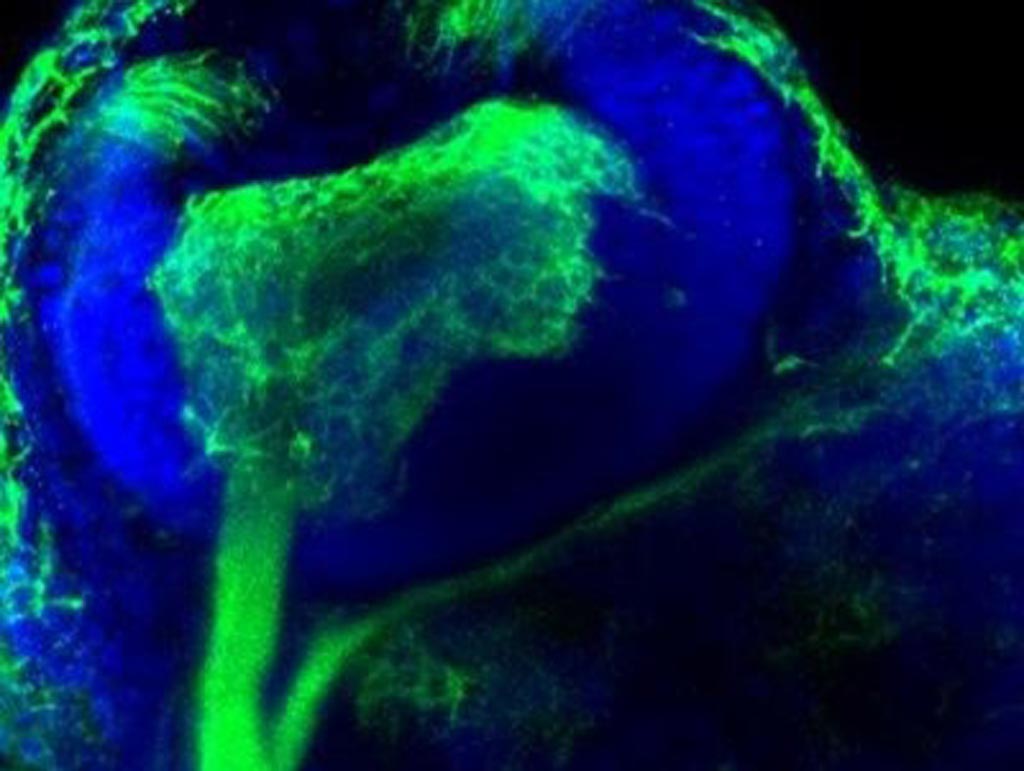Model Defines Role of Reactive Oxygen Species in Neural System Development
By LabMedica International staff writers
Posted on 24 Jul 2018
Using a mutant zebrafish model, a team researching development of the neural system has found a molecular mechanism linking reactive oxygen species to growth of the retina and its associated nerves.Posted on 24 Jul 2018
NADPH oxidase (Nox)-derived reactive oxygen species (ROS) have been linked to neuronal polarity, axonal outgrowth, cerebellar development, regeneration of sensory axons, and neuroplasticity. However, the specific roles that individual Nox isoforms play during nervous system development in vivo remain unclear.

Image: The eye of a zebrafish embryo deficient in NADPH oxidase 2 has an enlarged ganglion cell layer (green) and altered innervation of the brain, which leads to problems with signaling between the eyes and the brain (Photo courtesy of Dr. Daniel Suter, Purdue University).
To address this problem, investigators at Purdue University (West Lafayette, IN, USA) investigated the role of Nox activity in the development of retinotectal connections in zebrafish embryos. Zebrafish broadly express four NOX genes (NOX1, NOX2/CYBB, NOX5, and DUOX) throughout the central nervous system during early development. Application of a pan-Nox inhibitor, celastrol, during the time of optic nerve (ON) outgrowth resulted in significant expansion of the ganglion cell layer (GCL), thinning of the ON, and a decrease in retinal axons reaching the optic tectum. With the exception of GCL expansion, these effects were partially corrected by the addition of hydrogen peroxide, a key ROS involved in Nox signaling.
To address isoform-specific Nox functions, the investigators used CRISPR/Cas9 gene editing to generate mutations in each zebrafish NOX gene. CRISPR/Cas9 is regarded as the cutting edge of molecular biology technology. CRISPRs (clustered regularly interspaced short palindromic repeats) are segments of prokaryotic DNA containing short repetitions of base sequences. Each repetition is followed by short segments of "spacer DNA" from previous exposures to a bacterial virus or plasmid. Since 2013, the CRISPR/Cas9 system has been used in research for gene editing (adding, disrupting, or changing the sequence of specific genes) and gene regulation. By delivering the Cas9 enzyme and appropriate guide RNAs (sgRNAs) into a cell, the organism's genome can be cut at any desired location. The conventional CRISPR/Cas9 system is composed of two parts: the Cas9 enzyme, which cleaves the DNA molecule and specific RNA guides that shepherd the Cas9 protein to the target gene on a DNA strand.
The investigators reported in the June 27, 2018, online edition of The Journal of Neuroscience that NOX2/CYBB chimeric mutants displayed ON thinning and decreased OT innervation. Furthermore, NOX2/CYBB homozygous mutants showed significant GCL expansion and mistargeted retinal axons in the optic tectum.
"This is really a study about the role of ROS as signaling molecules in normal development, but it has key applications for human health," said senior author Dr. Daniel Suter. "If you take too many antioxidants to treat disorders or injuries, you could go into a range where you get negative effects, because ultimately you need some ROS for normal signaling. We are trying to figure out if there is a certain range that's best."
Related Links:
Purdue University













